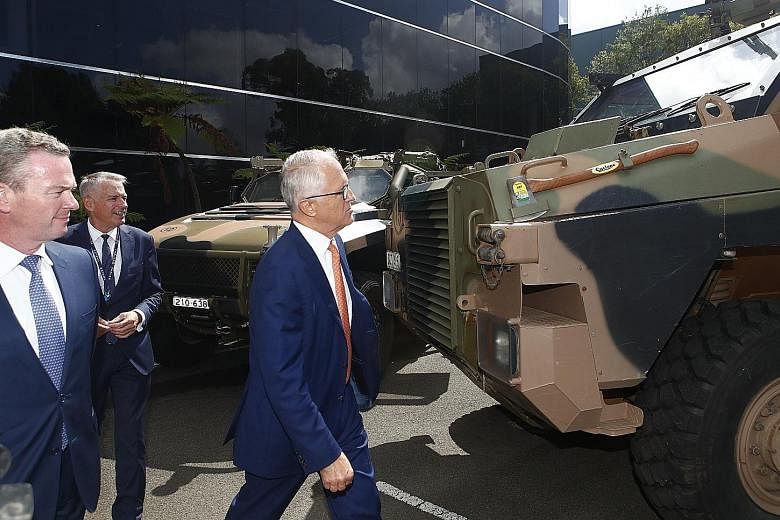Prime Minister Malcolm Turnbull has floated an ambitious plan to turn Australia into one of the top 10 defence exporters by 2028, but it was swiftly denounced as an unachievable "fairy tale".
For decades, Australia has touted plans to boost its arms exports, which are quite meagre compared with its annual defence budget.
Despite being the world's 12th biggest military spender, with a defence budget this year of A$34.6 billion (S$35.9 billion), Australia's exports last year came to about A$1.5 billion to A$2.5 billion. It is the 20th biggest arms exporter in the world.
Mr Turnbull wants Australia to enter the top 10 in arms exports, a list led by the United States, Russia, China, France and Germany. He wants to boost exports to allies and to countries in Asia and the Middle East, but has not set a target amount. As part of this goal, he will set up a A$3.8 billion loan facility to assist arms exporters.
Mr Turnbull said the plan would boost manufacturing skills, create "high-tech, cutting-edge jobs" and help to capitalise on Australia's investment in the local defence sector.
Business and industry groups have lauded the plan, saying it would help the local sector grow and supply more hardware to the Australian military.
But the plan has been heavily criticised by defence experts, who say the nation's military manufacturing sector is too small and will never be able to compete with large defence producers such as the US, Russia and China.
-
BIG SPENDER
-
A$34.6b
Australia's defence budget this year. The country is the world's 12th biggest military spender.
-
A$1.5b - A$2.5b
Australia's defence exports last year. It is the world's 20th biggest arms exporter.
For Australia to be among the top 10 exporters - overtaking countries such as South Korea and the Netherlands - its total volumes would have to grow by about 500 per cent in a decade.
It would also have to replace Israel, now in 10th place, according to the Stockholm International Peace Research Institute. Israel's military exports last year were worth US$6.5 billion (S$8.6 billion), according to government figures.
A former deputy secretary in the Department of Defence, Mr Fred Bennett, said Australia had little chance of competing in a sector that is fiercely competitive and often involves manipulation and intervention by governments. He said any decision by Canberra to commit funds to the sector is a "dubious investment".
"To believe that Australian companies can succeed in this market in the face of the decline of our manufacturing sector under the pressure of relatively high energy and labour costs, a strong currency and adversarial industrial relations is to believe a fairy tale," he said in a letter to The Australian newspaper on Feb 1.
Describing the proposed A$3.8 billion scheme as a "waste", he added: "No one with knowledge of the global defence equipment market should believe a word of it."
Other experts agreed, noting that Australia should focus on boosting skills in proven sectors such as agriculture and mining.
The country has achieved some export successes in the defence sector, mainly with niche products or specialised components and technologies. These include the Nulka decoy missile, which protects warships from anti-ship missiles, and the Bushmaster, a rugged armoured vehicle which has been deployed in the Middle East, Africa and the Pacific.
The government's defence export strategy released late last month shows 47 per cent of military exports go to Canada, New Zealand, the United Kingdom and the US, 26 per cent to the Indo-Pacific region (including Asia), 21 per cent to Europe, 4 per cent to the Middle East and North Africa, and 2 per cent to others.
Former defence secretary Paul Barratt said any effort to actively boost exports and seek customers would result in "unacceptable" arms sales which risked placing weapons into the wrong hands.
"As soon as you say we want to sell a certain volume of defence equipment, you will start pushing the boundaries of what is appropriate," he told ABC Radio on Jan 29.
"Who are the good guys in the Middle East? I can't think of a single country I would like to see us exporting our defence equipment to."
The government has insisted it would place strict oversight over sales to ensure weapons are not sold to countries which could misuse them.
But the export proposal has caused outrage among aid groups.
Amnesty International said it is concerned about Australia's plans to boost arms sales to countries which may use them to violate international human rights.
"When the government talks about expanding arms exports to the Middle East, where exactly does it mean? Syria? Saudi Arabia?" asked Ms Diana Sayed, a crisis campaign coordinater for Amnesty International Australia.
"And when it talks about the Indo-Pacific, is it contemplating Myanmar? The Philippines? We are seriously concerned about indications that the Australian government intends to become a major arms exporter to volatile regions that have appalling human rights records."
But Defence Industry Minister Christopher Pyne has dismissed these concerns, insisting that exporters would focus on Australian allies such as the US, Britain, New Zealand and Canada. He also mentioned boosting sales to India, Japan, South Korea and Malaysia.
In the government's export strategy, the Asia and Pacific regions present growing potential for boosting arms exports. "Australia has strong strategic interests in the security and stability of its immediate region, which is home to some of the most rapidly developing economies," the strategy states.

